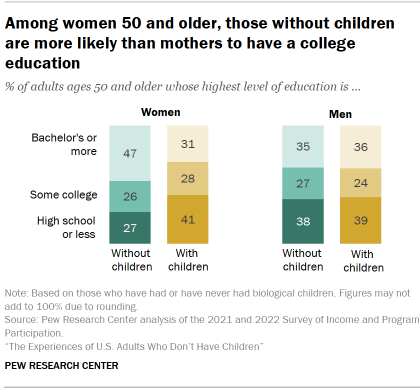One-in-five U.S. adults ages 50 and older have never had children, according to Pew Research Center analysis of government data.5

Not having children is more common among adults in their 50s and 60s than those in their 70s. Today, 23% of adults in their 50s and 22% of those in their 60s have never had children, compared with 15% of those in their 70s. (The data doesn’t go back far enough to allow us to analyze how these figures have changed over time).
This chapter looks at how adults ages 50 and older who haven’t had children compare with parents in the same age group in terms of their demographic and economic characteristics.
Among the key findings:
- Adults without children are less likely to have ever been married.
- Women without children are more likely than mothers to have a college degree and to be employed.
- Adults without children (both married and unmarried) are better off than parents in terms of median wealth and retirement savings.
Educational attainment
Among adults ages 50 and older, those who don’t have children are more likely than parents to have a four-year college degree. This is mostly driven by higher levels of educational attainment among women without children.

Almost half of women ages 50 and older who don’t have children (47%) have at least a bachelor’s degree; this compares with 31% of mothers in this age group. In turn, 41% of mothers have a high school diploma or less education, compared with 27% of women who have never had children.
Women without children are also more likely than men without children to have a college education: 35% of men ages 50 and older without children have a four-year degree. Older men with and without children are about equally likely to have a bachelor’s degree or more education.
Marital status and living arrangements
Adults ages 50 and older who have never had children often have different family and living arrangements than parents in their age group. Particularly, adults without kids are less likely to be married and more likely to live by themselves.
While there are differences in the marital status of both men and women without children when compared with their counterparts who are parents, the difference is more pronounced among men.

About three-quarters of fathers ages 50 and older (73%) are married, compared with 43% of men in the same age group who don’t have children.
Among women ages 50 and older, 57% of mothers are married, versus 41% of women in this age group who don’t have children.

The share of older adults without children who have never been married is 37% for men and 32% for women. By comparison, just 3% of fathers and 5% of mothers in this age group have never been married.
When it comes to living arrangements, about two-thirds of parents ages 50 and older (66%) live with a spouse or partner. This is true of 46% of older adults without kids.
In turn, adults who have never had kids are nearly twice as likely as parents to live alone (37% vs. 20%). Adults without children are also more likely to be living with at least one of their own parents (7% vs. 2% of those who have children).
Employment, wages and wealth
Many adults ages 50 and older are no longer working.
Among women in this age group, those who don’t have children are more likely than mothers to be employed (46% vs. 37%).

That difference is driven by a gap among women ages 65 and older: 21% of women in this age group who don’t have children are employed, compared with 14% of those who are parents. The difference in employment status among women ages 50 to 64 is not significant.
Men ages 50 and older with and without children are about equally likely to be employed (50% vs. 49%).

Among employed women, those without children earn more than mothers ($4,232 vs. $3,407 in median monthly wages). The opposite is true among employed men: Those without children earn less than fathers ($4,392 vs. $5,292 in median monthly wages).
Overall, among those ages 50 and older, adults without children have lower household incomes than parents do. But this differs by marital status.

Among unmarried adults (including those living with a partner they’re not married to), those who don’t have children have higher monthly household incomes in addition to higher net worth and larger retirement accounts when compared with those who are parents. For married adults, the pattern is similar, except for on household income.
Financial outcomes also differ by gender among those who are not married.
- Among unmarried men, those with and without kids have similar levels of income and retirement savings. But men without children have higher net worth than fathers.
- Among unmarried women, those without children do better than mothers when it comes to their monthly household income, net worth and retirement savings.




